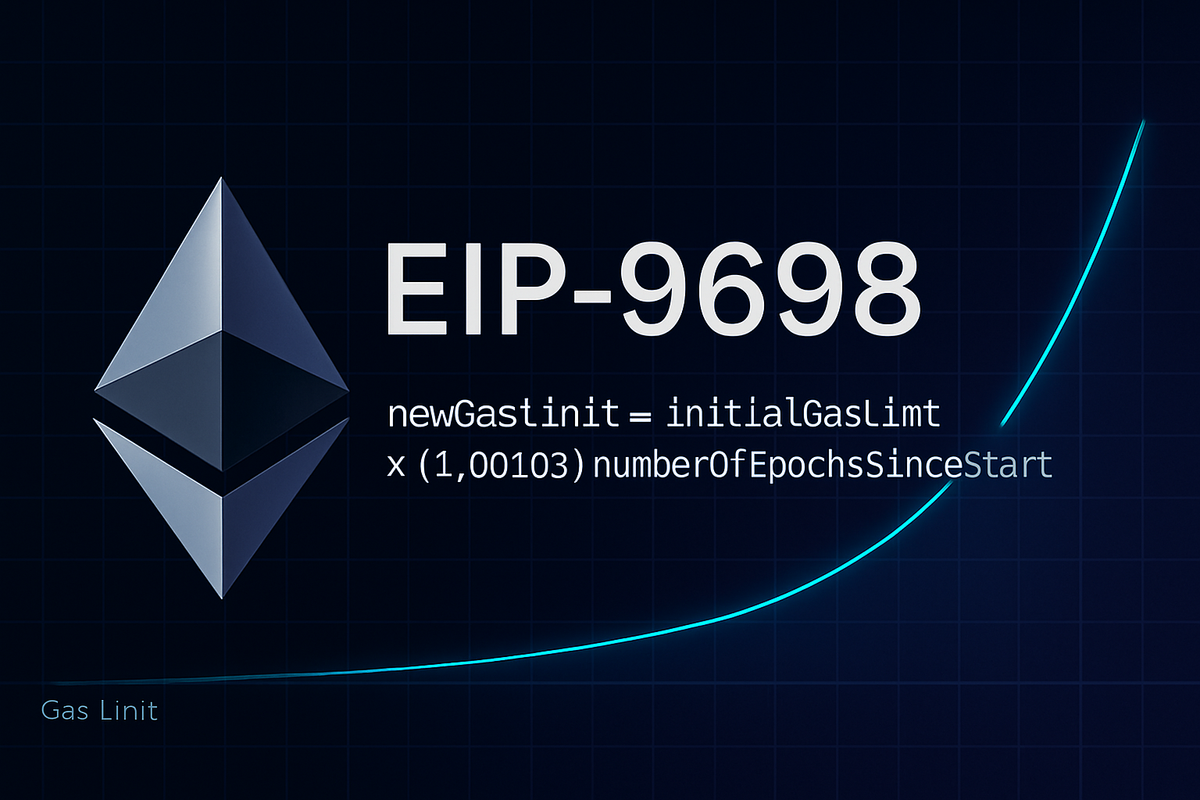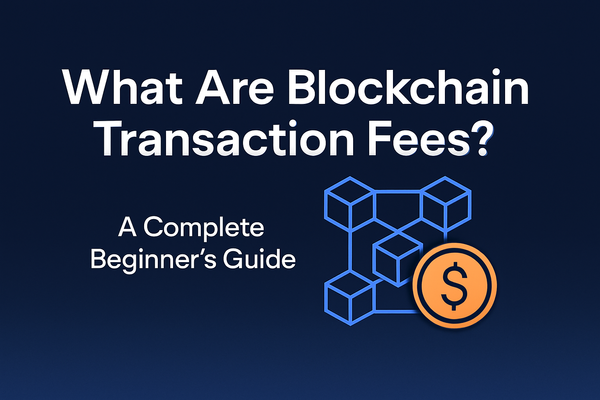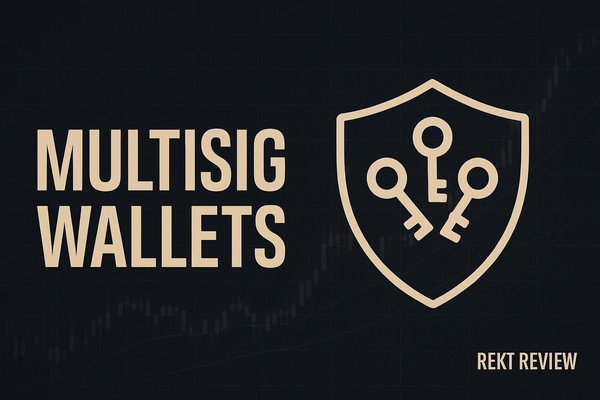Ethereum EIP-9698: Can a Hardcoded Gas Limit Boost Save the Network?
EIP-9698 could reshape Ethereum’s scalability by hardcoding gas limit increases directly into the protocol. Here’s what’s at stake.

Ethereum, the world's most widely used smart contract platform, has long battled a fundamental trade-off: decentralization versus scalability. As the network continues to secure billions of dollars in assets and serve as the backbone for DeFi, NFTs, and DAOs, its limited transaction throughput remains a major bottleneck. Despite Layer 2 rollups and recent upgrades like Dencun offering relief, demand consistently outpaces supply, leading to congestion and high gas fees.
In response, a new Ethereum Improvement Proposal—EIP-9698—has emerged as a bold attempt to expand the network’s capabilities. Authored by Ethereum Foundation researcher Barnabé Monnot, the proposal outlines a deterministic roadmap to increase the gas limit by 100x over four years. Unlike typical adjustments that rely on community or miner consensus, EIP-9698 would hardcode a predictable schedule of growth directly into the protocol.
If adopted, this change could drastically boost Ethereum’s transaction throughput while reshaping the trade-offs that have defined its evolution. But with greater capacity comes greater scrutiny. Can Ethereum handle exponential scaling without compromising its decentralization or security? EIP-9698 may hold the answer—or spark even more debate.
Understanding EIP-9698: A Proposal for Exponential Growth
Ethereum Improvement Proposal 9698 (EIP-9698) introduces a radical concept: hardcoding exponential gas limit increases directly into the Ethereum protocol. Rather than relying on network participants to manually adjust the gas ceiling—a process prone to hesitation and misalignment—this proposal sets a predictable growth trajectory designed to increase Ethereum's transaction capacity by 100x over four years.
Authored by Barnabé Monnot, EIP-9698 schedules automatic gas limit increases at regular intervals called epochs. Specifically, every 8192 blocks (approximately 27.3 hours), the gas limit would rise by 0.103%—a seemingly small change that compounds over time. By the end of the four-year schedule, this would result in a gas limit of approximately 300 million units, up from the current ~30 million.
Crucially, EIP-9698 is deterministic. Each client calculates the gas limit increase independently, ensuring that all Ethereum nodes remain in sync without the need for consensus signaling. This approach aims to minimize political friction and technical inconsistency that might otherwise slow down scalability improvements.
The proposal is not intended to be a short-term fix. Instead, it's a vision-aligned structural change meant to prepare Ethereum for a more demanding future. If successful, it could elevate Ethereum’s base layer throughput from ~15 transactions per second (TPS) today to potentially over 2,000 TPS—without waiting on external scaling solutions.
Technical Mechanics: How the Gas Limit Increase Works
At the heart of EIP-9698 lies a mathematical mechanism that governs how the gas limit increases over time—without relying on user coordination, miner votes, or protocol upgrades. The process is driven by a simple yet powerful idea: exponential, deterministic growth baked into the Ethereum protocol itself.
Each Ethereum block includes a gasLimit parameter that sets the maximum computational effort allowed. Under current rules, miners can increase or decrease the gas limit slightly with each block. EIP-9698 eliminates this flexibility by replacing it with a hardcoded function tied to epochs—fixed periods of 8192 blocks (~27.3 hours). At the start of each epoch, every Ethereum node independently recalculates the gas limit using the following formula:
newGasLimit = initialGasLimit × (1.00103)numberOfEpochsSinceStart
This deterministic update ensures that all clients stay aligned without the need for communication. The growth rate of 0.103% per epoch may seem modest, but when compounded over 52,000+ epochs in four years, it results in a 100x increase from today’s levels.
To maintain this schedule, EIP-9698 would define a precise activation epoch—proposed to begin on June 1, 2025 at epoch 369017. From that point forward, the protocol would take over control of gas limit increases, rendering manual adjustment obsolete.
An important detail is that this system only increases the gas limit. There is no mechanism in EIP-9698 to reduce it, even in response to network congestion or instability. This one-way progression has raised concerns in some circles, but it also brings predictability—making it easier for developers, users, and scaling solution providers to plan ahead.
Comparative Analysis: Ethereum vs. Competing Blockchains
Ethereum’s current transaction throughput—around 15 transactions per second (TPS) on the base layer—lags far behind some of its most aggressive competitors. Blockchains like Solana, Sui, and Aptos boast hundreds or even thousands of TPS, often marketing this as a major differentiator. While many of these figures rely on ideal conditions or parallelized execution models, they do reflect real pressure on Ethereum to scale.
Enter EIP-9698. If implemented, the proposal could raise Ethereum’s gas limit enough to support over 2,000 TPS, bringing it into the same performance bracket as newer Layer 1 chains—without compromising its deep developer ecosystem or battle-tested security. The difference, however, lies in how scalability is achieved.
Solana emphasizes monolithic design and high hardware requirements, allowing it to process a high volume of transactions with low latency. Ethereum, by contrast, is scaling through a modular architecture—Layer 2 rollups, sharding (eventually), and proposals like EIP-9698 that enhance the base layer in a sustainable way. It’s a fundamentally different philosophy: robustness first, then speed.
The real question isn’t whether Ethereum can “catch up” in raw numbers—it’s whether it can do so without breaking itself. That’s what makes EIP-9698 notable: it offers a path toward Solana-level throughput while staying true to Ethereum’s decentralized DNA.
Potential Benefits: Throughput, Costs, and User Experience
The most obvious benefit of EIP-9698 is higher throughput. By increasing the gas limit on a predictable schedule, Ethereum can process far more transactions per second—potentially exceeding 2,000 TPS on the base layer alone. This would dramatically reduce wait times during peak usage, something that’s plagued the network during bull runs and NFT drops.
Increased throughput typically leads to lower gas fees. With more block space available, users won’t need to outbid each other as aggressively to have their transactions confirmed. This change could make Ethereum feel faster and cheaper—two qualities that are essential for onboarding the next wave of users and developers.
For dApp builders, predictable gas growth offers planning advantages. Developers can design systems knowing that the network’s capacity will increase on a fixed timeline. This reduces uncertainty and allows for more ambitious on-chain applications without fearing sudden congestion spikes.
From a user experience standpoint, this proposal could narrow the usability gap between Ethereum and Web2 platforms. Faster confirmations, lower costs, and fewer failed transactions mean smoother interactions—whether you're minting NFTs, trading on DEXs, or simply sending ETH.
In short, EIP-9698 isn’t just about numbers. It’s about unlocking Ethereum’s potential as a mass-market infrastructure—not years from now, but on a measured and reliable schedule.
Challenges and Criticisms: Centralization and Node Strain
While EIP-9698 offers a bold vision for scaling Ethereum, it also introduces real risks—especially around centralization and network health.
The most immediate concern is node hardware strain. As the gas limit increases, the computational and storage demands on full nodes rise sharply. Over time, this could push out hobbyist operators and smaller validators, concentrating control among well-funded entities with access to high-performance infrastructure. Ethereum’s decentralization—arguably its greatest strength—could erode as a result.
There’s also the risk of state bloat. A 100x gas limit increase doesn’t just mean more transactions—it means significantly more data stored on-chain. Ethereum’s state is already growing rapidly, and exponential throughput could accelerate this beyond what current pruning and storage strategies can handle. This increases the risk of sync times ballooning and network instability if older nodes can’t keep up.
Critics also highlight the irreversibility of the growth. EIP-9698 only moves in one direction: up. There’s no mechanism to throttle or pause the increase if problems arise. While this deterministic design is intentional—removing politics and delays—it also removes flexibility. If the network begins to show signs of stress, it may be too late to respond effectively.
Finally, some argue that scaling should focus on Layer 2 solutions, not the base layer. Rollups like Arbitrum, Optimism, and zkSync are already absorbing significant transaction volume. Critics worry that EIP-9698 could undermine this ecosystem by making Layer 1 too accommodating—potentially fragmenting developer attention.
In essence, EIP-9698 is a high-reward, high-risk proposal. It promises throughput at scale—but Ethereum must be careful not to compromise the very decentralization that makes it valuable.
Community and Developer Perspectives
EIP-9698 has sparked a mix of curiosity, enthusiasm, and caution within the Ethereum community. Supporters see it as a visionary approach—one that cuts through coordination overhead and offers a clear path to on-chain scalability. Some developers appreciate its deterministic nature, arguing that predictability is preferable to the current, often politicized gas limit adjustments.
Barnabé Monnot, the proposal’s author, has positioned EIP-9698 not as a replacement for Layer 2s but as a complement to Ethereum’s broader scaling strategy. He emphasizes that the deterministic growth can provide a base layer strong enough to support rollups more reliably.
However, skepticism remains. Some core developers have voiced concern over the lack of a built-in safety valve. Others worry about the implications for node decentralization and how smaller validators will keep pace as hardware demands rise. On Ethereum research forums and GitHub threads, contributors continue to weigh in with technical critiques and alternative ideas.
There’s no overwhelming consensus yet—but that’s typical of early-stage EIPs. What’s clear is that EIP-9698 has triggered a vital conversation about how Ethereum should scale in a post-merge, post-rollup-centric world.
Integration with Upcoming Upgrades: Fusaka and Pectra
EIP-9698 doesn’t exist in isolation—it’s part of a broader evolution of Ethereum’s protocol. If adopted, the proposal could align with other major upgrades, particularly the upcoming Fusaka and Pectra hard forks.
Fusaka is expected to focus on improvements to Ethereum’s proof-of-stake validator set, aiming to streamline participation and reduce operational complexity. A higher gas limit would complement Fusaka by supporting more activity on-chain—whether from validators, smart contracts, or end users.
Pectra, meanwhile, may introduce features like Verkle trees, a long-awaited upgrade designed to reduce Ethereum’s state size and improve scalability. If Verkle trees land before or alongside EIP-9698, they could mitigate concerns around state bloat, making the gas limit expansion more sustainable.
Crucially, EIP-9698’s deterministic nature makes it relatively easy to slot into these upgrades. It doesn’t require new cryptographic primitives or complex coordination. That means it could be deployed with minimal friction—potentially even in sync with other roadmap milestones.
Together, these upgrades point to a future where Ethereum’s base layer becomes faster, lighter, and more scalable—all without compromising its security or decentralization ethos.
Conclusion: The Road Ahead for Ethereum
EIP-9698 represents a bold and deterministic approach to Ethereum’s long-standing scalability challenges. By hardcoding exponential gas limit increases, it removes the need for political consensus and injects predictability into Ethereum’s performance trajectory. It’s a sharp pivot from reactive scaling to proactive engineering.
But with great throughput comes great responsibility. The Ethereum community must weigh performance gains against the risk of centralization, node strain, and ecosystem disruption. As Fusaka, Pectra, and other upgrades loom, the question isn’t just whether EIP-9698 will work—it’s whether it will work for everyone.
Whether this proposal is adopted as-is or evolves into a hybrid approach, its emergence signals one thing clearly: Ethereum is no longer satisfied with incremental scaling. It’s ready to grow—deliberately, exponentially, and on its own terms.
Ethereum EIP-9698 FAQ
EIP-9698 is a proposal to increase Ethereum’s gas limit by 100x over four years using a deterministic, hardcoded growth schedule.
The gas limit increases automatically every 8192 blocks (roughly 27.3 hours), growing at a fixed rate of 0.103% per epoch.
EIP-9698 could dramatically boost Ethereum’s transaction throughput, reduce gas fees, and improve the overall user experience.
Key risks include increased node hardware demands, centralization, and long-term state bloat due to lack of a throttle mechanism.
EIP-9698 scales Ethereum’s Layer 1 directly. It’s separate from rollups or Layer 2 solutions but can complement them.
If accepted, the proposed start date is June 1, 2025, beginning with epoch 369017.





